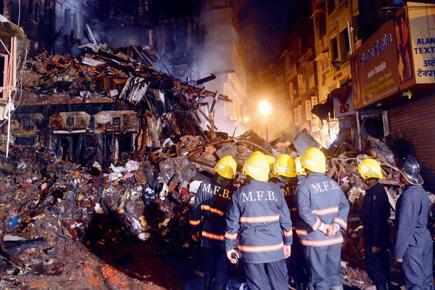City fire brigade, which lost two of its bravehearts to Kalbadevi inferno, should have 43 fire stations as against the existing 33; it also needs at least 130 pumping units instead of existing 88

Mumbaiu00c3u0083u00c2u00a2u00c3u0082u00c2u0080u00c3u0082u00c2u0099s firemen have to surmount some impossible odds in their line of duty
The Mumbai Fire Brigade, which lost two of its bravehearts to the Kalbadevi inferno on Saturday, falls short of meeting the standards set by the Central government for all fire brigades in the country.

Mumbai’s firemen have to surmount some impossible odds in their line of duty. File Pic
ADVERTISEMENT
According to the Standing Fire Advisory Council (SFAC) set up under the Ministry of Home Affairs (MHA) in 1955, the response time for fire-related emergencies should be three minutes in all high-hazard and closely built areas, and not more than five minutes in other areas.
Since Kalbadevi qualifies as the former, the fire brigade technically should have reached the area within three minutes. However, the officials who came from the Byculla fire station took 13 minutes to reach the spot.
In fact, in congested areas in the city — with traffic, hawkers, illegal parking, double-parking, speed breakers, signals and a large number of pedestrians jaywalking — the average response time of the Mumbai Fire Brigade has been between 10-20 minutes, depending on the location.
The guidelines also state that the city needs 44 fire stations instead of the existing 33; in addition, it needs at least 130 pumping units (including fire engines and water tankers) instead of the existing 88.
Central norms
The SFAC, a Central government body, meets every year and consists of the Director General of National Disaster Response Force & Civil Defence (NDRF&CD), fire adviser and deputy fire adviser to the MHA, directors general, chief fire officer or deputy fire officer of various states and representatives of various other central bodies. Its previous meeting was held in November 2014 in Goa.
The SFAC is India’s apex body, which governs matters related to fire safety. Its guidelines, known as ‘compendium of recommendations’ is the benchmark supposed to be followed by every fire-fighting agency. Although it is not mandatory, it is the minimum requirement supposed to be met by the district authorities.
According to the guidelines, every city with a population of more than one million must have one fire station for every 10.36 sq km. Thus, if Mumbai’s area is 437 sq km (as per the BMC), the city should have a minimum of 43 fire stations as against the existing 33. Mumbai has 33 fire stations including the city as well as suburbs, with two headquarters — one at Wadala and the other at Marol.
What’s more, the city should have six water-pumping units for a population up to 3 lakh and one for every subsequent lakh. This means Mumbai is supposed to have 130 water-pumping units for a population of 1.27 crore. It has only 88.
“These are the minimum requirements every city must meet. And in a city like Mumbai, which has a massive floating population, the guidelines should be exceeded, besides being met. I don’t think it is impossible to meet these guidelines. For example, the required number of fire stations can be met if a reservation is provided in the development plan. Cluster development for areas like Kalbadevi should also be explored now,” said Milind Deshmukh, director, Maharashtra Fire Services, who is also the state’s representative to SFAC.
“We are trying our best but sometimes things are beyond our control. For example, most of the proposed six command centres of the fire brigade are ready at different locations in the city. But they have not been inaugurated yet. Such are the problems,” said K V Hivrale, deputy chief fire officer of the Mumbai Fire Brigade.
“Hazardous locations like industrial units and petrol pumps have their own fire fighting mechanisms. But in non-hazardous or residential areas, it is impossible to reach within 5 minutes. Not just in Mumbai, the case is the same across metropolitan cities in the world. After all, these are just guidelines.
But we have proposed 26 new fire stations in the city, which will be constructed in phases. A provision will be made for them in the Development Plan since we have already identified land parcels. Besides, we are in the process of finalising tenders for 18 mini water tankers for the city,” said P S Rahangdale, deputy chief fire officer and acting chief fire officer.
 Subscribe today by clicking the link and stay updated with the latest news!" Click here!
Subscribe today by clicking the link and stay updated with the latest news!" Click here!







